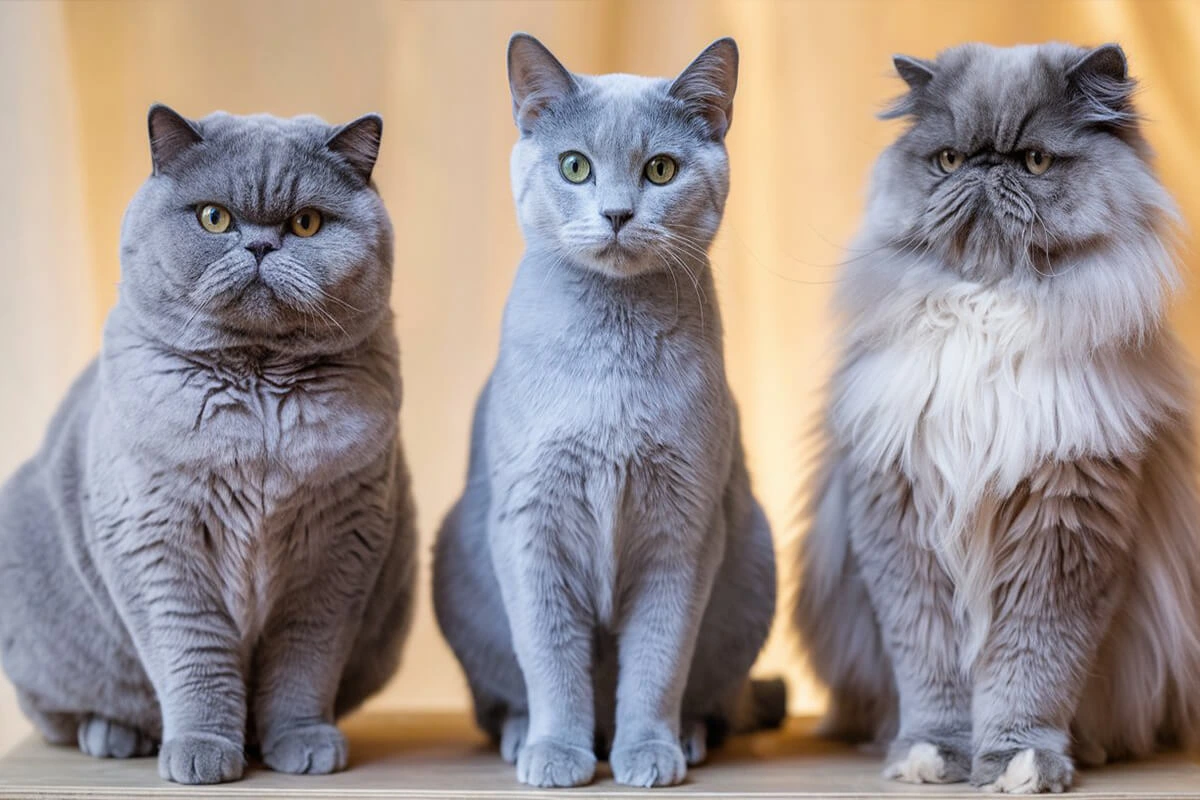A light grey cat brings elegance and charm to any home with its sleek, soft fur and captivating eyes. Whether you own a British Shorthair, a Russian Blue, or a Persian Cat, these felines require specific care to keep them happy and healthy. Their unique coat color makes them stand out, but it also demands proper maintenance to stay shiny and soft.
Caring for a light grey cat goes beyond feeding and grooming. Owners must focus on a well-balanced diet, regular vet visits, and proper behavioral training to ensure their feline friend thrives. Understanding their nutritional needs, investing in the right grooming tools, and providing mental and physical stimulation all play a crucial role in their overall well-being.
This guide will walk you through seven essential care tips, from grooming and nutrition to training and health management. Whether you’re a first-time cat owner or a seasoned pet parent, these tips will help you keep your grey-coated companion in top shape. Let’s dive into the best ways to care for your light grey cat!
Understanding Light Grey Cat Breeds
Popular Grey Cat Breeds
Several cat breeds showcase stunning light grey coats, each with its own unique characteristics. Some of the most well-known grey cat types are:
- British Shorthair – This breed has a dense, plush coat and a calm, affectionate nature. British Shorthairs love lounging around but also enjoy interactive play. Their thick fur needs to be brushed often to stop it from getting tangled.
- Russian Blue – Known for their sleek, short silver-blue fur and striking green eyes, Russian Blues have a reserved but loving personality. They tend to be independent and prefer a quiet, stable environment. Their short coat doesn’t require much grooming, but they shed seasonally and benefit from occasional brushing.
- Persian Cat – Persians have long, luxurious coats that need daily grooming to prevent tangles and hairballs. They have a sweet, laid-back temperament and love spending time with their owners. Their flat faces make them prone to breathing issues, so they need special care, especially in hot weather.
Unique Traits and Personality of Each Light grey cat Breed
Each grey cat breed has distinct traits that influence their care needs and lifestyle:
- British Shorthairs thrive in relaxed households and form strong bonds with their owners. They are not overly demanding but need a good balance of play and rest.
- Russian Blues can be shy around strangers but show deep affection for their family members. They appreciate a consistent routine and don’t like sudden changes in their environment.
- Persians enjoy a pampered lifestyle and require extra grooming due to their long coats. They are affectionate but prefer a calm, quiet home without too much hustle and bustle.
How Breed Differences Impact Care Routines
Understanding breed-specific needs helps owners provide better care for their grey cat:
- Grooming Needs – Long-haired breeds like Persians require daily brushing, while short-haired breeds like Russian Blues only need weekly grooming.
- Activity Levels – British Shorthairs and Persians are more laid-back, while Russian Blues are agile and enjoy interactive play. Providing the right toys and activities helps match their energy levels.
- Health Considerations – Persian cats need extra attention to their facial structure and breathing, while Russian Blues may develop weight issues if not given enough exercise. British Shorthairs, with their sturdy build, benefit from a controlled diet to prevent obesity.
Choosing the right care routine based on breed-specific traits ensures a happy, healthy life for your light grey cat. Whether they need frequent grooming, structured playtime, or special health monitoring, understanding their breed helps you provide the best possible care.
Light Grey Cat Grooming Tips for a Healthy and Shiny Coat
Importance of Cat Fur Maintenance
A light grey cat’s coat needs regular maintenance to stay healthy, soft, and vibrant. Proper fur care does more than keep your cat looking beautiful—it also prevents skin issues, reduces shedding, and minimizes the risk of hairballs. Regular grooming removes dirt, dead hair, and loose dander, helping your cat stay comfortable and reducing allergens in your home.
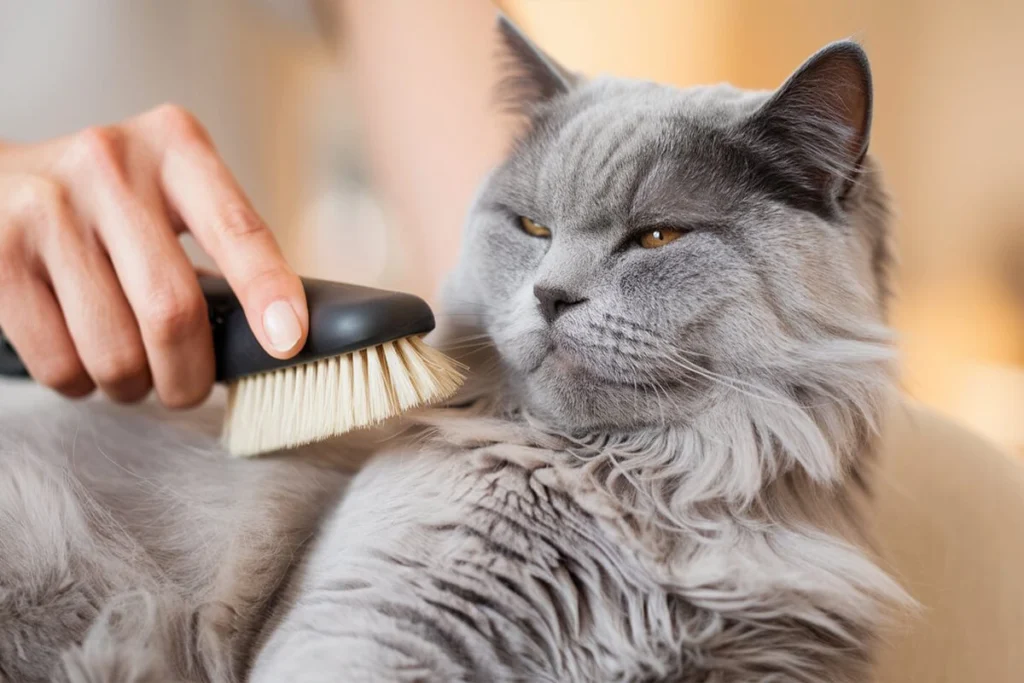
Cats groom themselves naturally, but their tongues can’t remove all the loose hair, especially for long-haired breeds. Without assistance, loose fur builds up, leading to matting, excessive shedding, and hairball formation. Owners who prioritize fur maintenance help their cats stay cleaner and healthier while reducing unwanted fur on furniture and clothing.
Brushing Routines Based on Coat Length (Short vs. Long Hair)
Different coat lengths require different grooming approaches. A short-haired Russian Blue won’t need as much brushing as a long-haired Persian, but both still benefit from routine grooming.
- Short-Haired Cats (British Shorthair, Russian Blue)
- Brush once or twice a week to remove loose hair and distribute natural oils.
- Use a soft-bristle brush or a rubber grooming mitt to avoid irritating the skin.
- Increase brushing frequency during seasonal shedding periods.
- Long-Haired Cats (Persian Cat, Long-Haired British Shorthair)
- Brush daily to prevent tangles and matting.
- Use a wide-tooth comb first, then a fine-tooth comb for deeper grooming.
- Pay special attention to areas prone to knots, like behind the ears and under the legs.
Best Grooming Tools for The Light Grey Cat
Choosing the right grooming tools makes brushing more effective and comfortable for your cat. Here are some must-have tools for maintaining a light grey cat’s coat:
- Slicker Brush – Best for removing loose fur and preventing mats, especially for long-haired breeds.
- Rubber Grooming Mitt – Helps short-haired cats shed excess fur while giving them a gentle massage.
- Deshedding Tool (like a FURminator) – Works well for cats that shed heavily, reducing fur buildup and hairballs.
- Wide-Tooth and Fine-Tooth Combs – Essential for long-haired cats to untangle knots and remove debris.
Managing Shedding and Hairballs
Every cat sheds, but excessive shedding leads to hairballs, allergies, and extra cleaning around the house. Managing shedding helps keep your cat comfortable and your home fur-free.
- Regular Brushing – The best way to control shedding is by removing loose fur before it falls out.
- Healthy Diet – A diet rich in feline nutrition with Omega-3 and Omega-6 fatty acids strengthens fur and reduces shedding.
- Hydration – Encouraging cat hydration keeps their skin moisturized and prevents excessive shedding.
- Hairball Remedies – Specialized cat food, hairball-control treats, or adding a small amount of cat-safe oil (like fish oil) to their diet can help reduce hairball formation.
A consistent grooming routine keeps a light grey cat’s coat in top condition, preventing excessive shedding and hairballs while strengthening the bond between pet and owner. Regular brushing and proper tools make grooming easier, keeping your feline friend comfortable, healthy, and looking their best.
Nutrition: The Best Diet for Your Light Grey Cat
Importance of Feline Nutrition for a Healthy Coat and Energy Levels
A light grey cat needs a well-balanced diet to maintain a soft, shiny coat and high energy levels. The right nutrition directly affects fur quality, preventing dullness, excessive shedding, and skin issues. A nutrient-rich diet also fuels your cat’s daily activities, keeping them playful and alert.
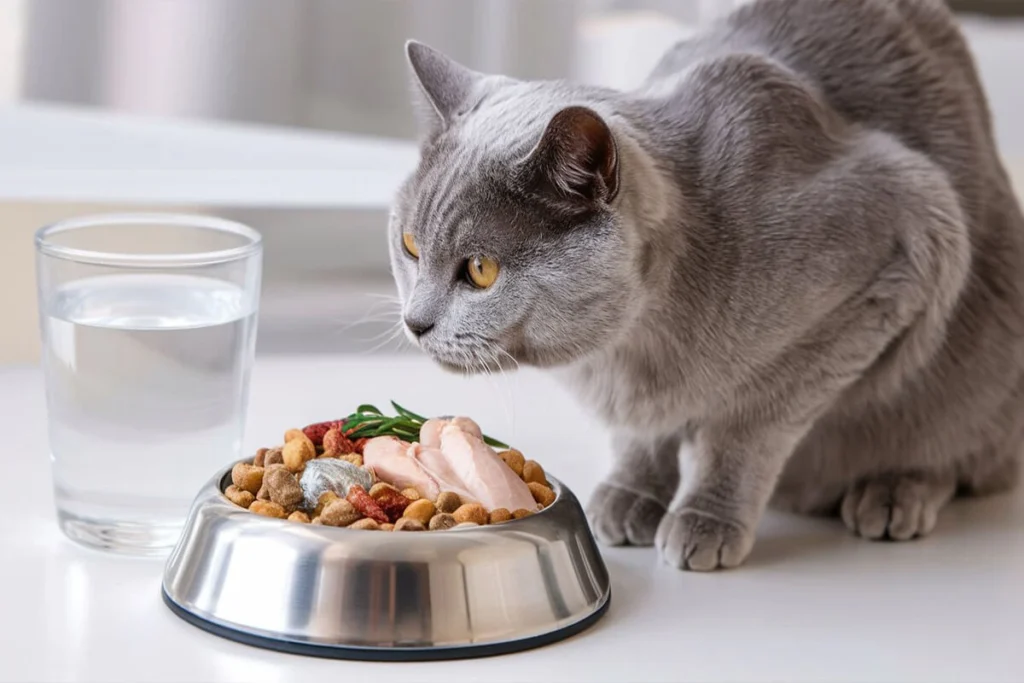
Cats thrive on protein-based meals since they are obligate carnivores. Without enough high-quality protein, their coats lose luster, and they may develop weak muscles or low energy. Essential fatty acids, vitamins, and minerals support skin hydration and fur strength, reducing hair loss and irritation. A poorly balanced diet can lead to dryness, dandruff, and a brittle coat, making grooming more difficult.
Best Cat Food for Grey Cats
Choosing the right food for your grey cat ensures they receive proper nutrients to keep their coat and body healthy. Look for premium-quality wet or dry food with real animal protein as the first ingredient. Some of the best cat food options for grey cats include:
- High-Protein Wet Food – Brands offering protein-rich canned food with real meat help keep your cat hydrated and support muscle health.
- Grain-Free Dry Kibble – Some cats do well on grain-free diets, reducing the risk of food allergies and improving digestion.
- Hairball Control Formulas – Specially designed food with fiber blends helps long-haired grey cats manage shedding and prevent hairballs.
- Omega-3 and Omega-6 Enriched Food – These essential fatty acids improve skin health and give grey fur a natural sheen.
Each cat has unique dietary needs, so choosing a food that supports their coat, digestion, and energy levels will make a big difference in their overall well-being.
Essential Nutrients and Ingredients to Look For
A high-quality diet must include specific nutrients to promote a light grey cat’s coat health and energy. Look for the following ingredients in cat food:
- Animal-Based Protein (Chicken, Turkey, Fish, or Beef) – Supports muscle growth and maintains a healthy metabolism.
- Omega-3 and Omega-6 Fatty Acids – Found in fish oil and flaxseed, these nutrients enhance fur shine and reduce inflammation.
- Taurine – An essential amino acid that supports heart health, vision, and immune function.
- Vitamins A and E – Help maintain skin elasticity, prevent dryness, and strengthen hair follicles.
- Biotin and Zinc – Improve coat texture and help prevent excessive shedding.
- Fiber (Pumpkin, Beet Pulp, or Psyllium Husk) – Aids digestion and reduces hairball formation.
Avoid artificial fillers, preservatives, and excessive carbohydrates, as they provide little nutritional value and may cause digestive issues or weight gain.
Importance of Cat Hydration and Fresh Water Availability
Proper cat hydration plays a vital role in maintaining a shiny coat and overall health. Dehydration leads to dry skin, increased shedding, and a dull coat. Cats naturally have a low thirst drive, especially if they eat primarily dry food, so encouraging water intake prevents health issues like urinary tract infections and kidney disease.
To keep your light grey cat well-hydrated:
- Provide Fresh Water Daily – Refresh their water bowl at least once a day to keep it clean and appealing.
- Use a Cat Water Fountain – Many cats prefer running water, making a fountain a great way to increase their water consumption.
- Feed Wet Food – Canned food contains up to 80% moisture, making it an excellent way to boost hydration.
- Add Water or Broth to Meals – Mixing a little water or low-sodium bone broth into their food adds extra moisture and flavor.
A well-hydrated cat has a healthier coat, better digestion, and improved kidney function. Ensuring proper hydration and a nutrient-rich diet keeps your grey cat full of energy and looking their best every day.
Keeping Your Light Grey Cat Happy and Well-Behaved
Basics of Cat Behavior Training for a Well-Adjusted Pet
Training a light grey cat helps create a well-adjusted, happy pet that fits into your home smoothly. Cats may seem independent, but they still need guidance to develop good habits and social behaviors. Effective training starts with consistency, positive reinforcement, and an understanding of feline instincts.
Start by reinforcing desired behaviors with treats, praise, or petting. If your cat uses the litter box correctly, scratches the right surfaces, or follows commands, reward them immediately. Avoid punishment, as it creates fear and confusion. Instead, redirect unwanted behaviors toward acceptable alternatives.
Socialization also plays a huge role in cat training. Expose your cat to different people, sounds, and experiences early on. A well-socialized grey cat adapts more easily to new situations and becomes less fearful in unfamiliar environments. Whether you train a kitten or an older cat, patience and routine make the process smoother.
Importance of Playtime and Mental Stimulation
A light grey cat needs daily playtime to stay mentally and physically engaged. Play sessions prevent boredom, reduce stress, and help manage behavioral issues like excessive meowing or destructive scratching. Cats naturally hunt, so interactive play mimics their hunting instincts and keeps them entertained.
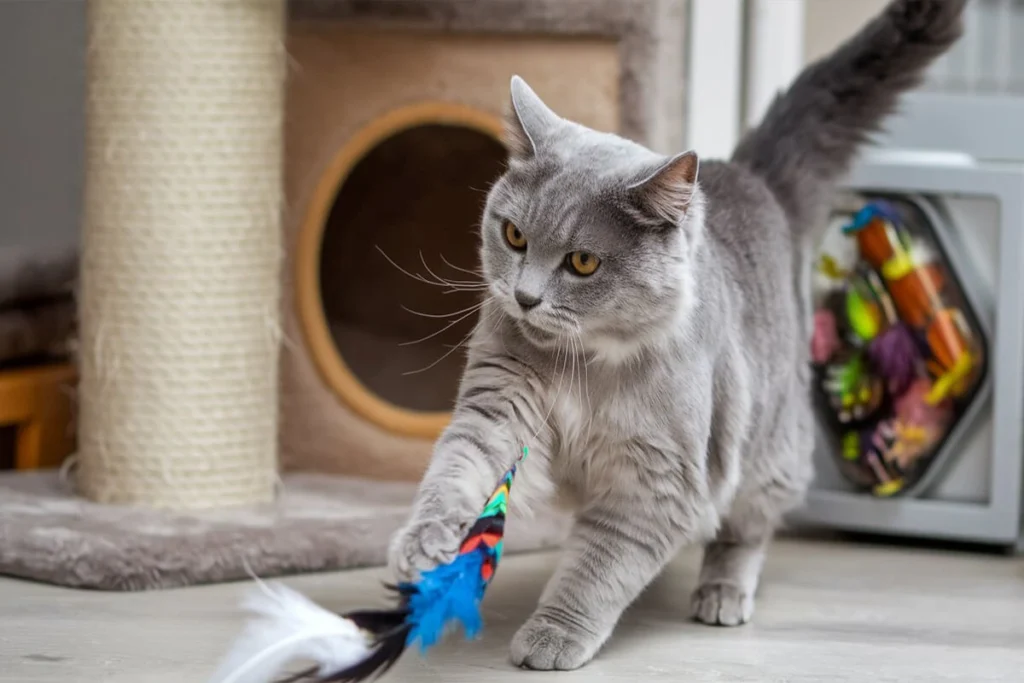
Try a variety of play activities to engage your cat’s senses:
- Wand Toys with Feathers or Strings – Encourage pouncing and jumping for exercise.
- Laser Pointers – Stimulate their natural prey drive, but always finish with a tangible toy so they “catch” something.
- Puzzle Feeders – Challenge their minds while rewarding them with food.
- Climbing and Scratching Posts – Provide exercise and a safe outlet for scratching.
Play sessions also strengthen your bond with your cat. Set aside at least 15–30 minutes daily to engage them with toys and activities they enjoy. If you have a busy schedule, automated toys and interactive feeders can keep them entertained while you’re away.
Training Tips to Prevent Unwanted Behaviors (Scratching, Jumping on Counters)
Unwanted behaviors like scratching furniture or jumping on counters can frustrate cat owners. Instead of scolding, focus on redirecting these behaviors toward acceptable alternatives.
- Scratching Furniture
- Place scratching posts near their favorite spots.
- Use double-sided tape or citrus sprays on furniture to discourage scratching.
- Trim their nails regularly and provide a scratching pad infused with catnip.
- Jumping on Counters
- Remove tempting food and items that attract them.
- Offer vertical alternatives like cat trees or shelves.
- Use deterrents like aluminum foil or motion-activated sprays to make counters unappealing.
- Biting or Play Aggression
- Avoid using hands or feet as toys to prevent rough play.
- Provide chew toys and engage them in interactive play to release excess energy.
- If they bite too hard, stop playtime immediately to reinforce gentle behavior.
Consistency and patience play key roles in training. Reinforce good behavior with rewards, and soon your cat will learn what is and isn’t allowed.
Choosing the Right Cat Scratching Post and Toys
A scratching post satisfies your cat’s natural need to scratch while protecting your furniture. The best scratching post fits your cat’s size, scratching preference, and activity level.
- Material: Sisal fabric or rope works best for satisfying their scratching needs.
- Height: Choose a post at least 30 inches tall so your cat can stretch fully.
- Stability: Ensure it’s sturdy to prevent tipping over.
If your cat prefers horizontal scratching, use flat cardboard scratchers or carpeted mats. Offering different textures and shapes encourages proper scratching habits.
Choosing the right toys also improves your cat’s well-being. Select toys that match their play style:
- Chase & Hunt: Feather wands, toy mice, or balls.
- Interactive: Treat-dispensing puzzles and moving toys.
- Solo Play: Catnip-stuffed plushies or motion-activated toys.
Providing the right scratching posts and toys prevents destructive behaviors, keeps your light grey cat entertained, and helps them stay physically active. By meeting their natural instincts, you create a happier and healthier pet.
Health and Wellness: Ensuring a Long, Happy Life
Importance of Regular Vet Check-Ups
Routine vet check-ups keep your light grey cat healthy and help detect potential health issues before they become serious. Cats are masters at hiding illness, so even if your feline appears fine, underlying conditions may go unnoticed without regular veterinary visits.
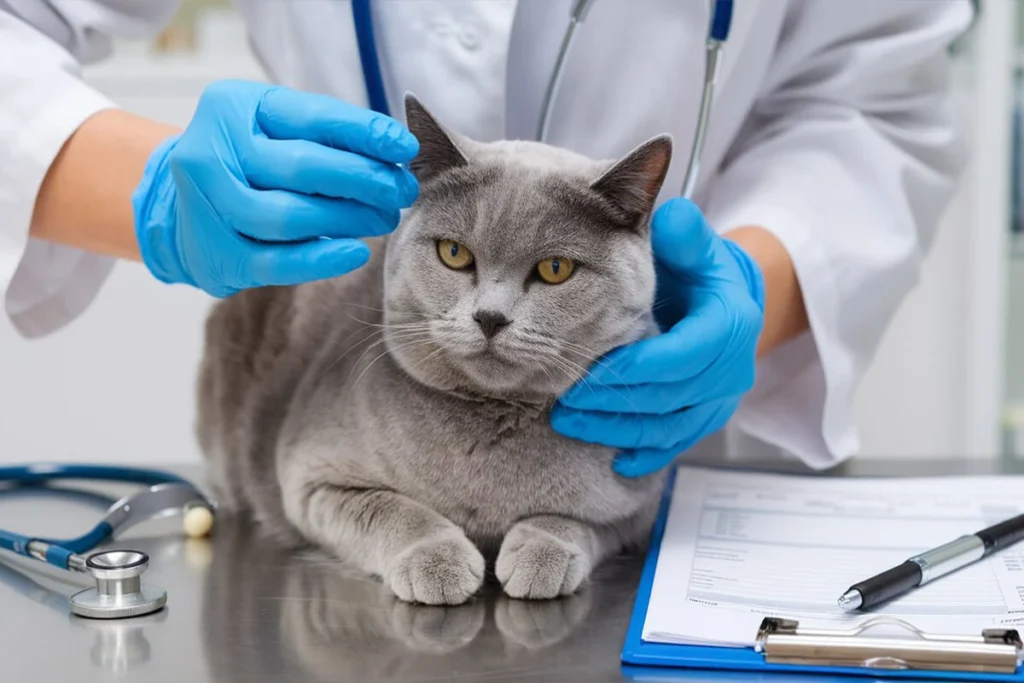
Veterinarians perform physical exams, dental checks, and routine blood tests to monitor overall health. They assess weight, heart function, joint movement, and coat condition to spot early signs of problems. Vaccinations and parasite control also play a critical role in keeping your cat protected from common diseases and infections.
Schedule a vet visit at least once a year for adult cats and twice a year for senior cats. Kittens require more frequent check-ups during their first year to ensure proper development and vaccinations. Preventative care saves time, stress, and money by avoiding costly emergency treatments later on.
Common Health Issues in The Light Grey Cat and Prevention Tips
While light grey cats don’t face unique health problems solely because of their coat color, certain breeds, like British Shorthairs, Russian Blues, and Persians, are more prone to specific conditions. Understanding these risks allows owners to take preventive measures.
- Obesity (British Shorthairs & Russian Blues)
- Monitor portion sizes and avoid excessive treats.
- Provide daily exercise with interactive toys.
- Choose a high-protein, low-carb diet.
- Respiratory Issues (Persian Cats)
- Keep their environment dust-free.
- Use a shallow food bowl to prevent breathing difficulties.
- Regularly clean their facial folds to avoid bacterial buildup.
- Bladder Stones & Urinary Tract Infections (All Breeds)
- Ensure proper hydration by providing fresh water daily.
- Feed wet food to support urinary health.
- Watch for frequent or painful urination and consult a vet immediately.
- Dental Disease (All Breeds)
- Brush teeth regularly with cat-safe toothpaste.
- Offer dental treats or toys that promote oral health.
- Schedule annual dental cleanings with a veterinarian.
Preventing these conditions requires proper nutrition, hydration, exercise, and regular vet care. A well-balanced approach keeps your grey cat feeling their best.
Signs of Illness Every Cat Owner Should Watch For
Cats instinctively hide pain and discomfort, making it essential for owners to recognize subtle changes in behavior or appearance. Early detection can prevent minor health issues from developing into serious conditions.
Watch for these warning signs:
- Changes in Appetite or Weight – Eating too much or too little could indicate an underlying health issue. Sudden weight loss or gain also signals a potential problem.
- Lethargy or Decreased Activity – If your usually playful cat becomes uninterested in toys or sleepier than usual, they might not be feeling well.
- Vomiting or Diarrhea – Occasional hairballs are normal, but frequent vomiting, diarrhea, or constipation could indicate digestive issues or food allergies.
- Excessive Scratching or Hair Loss – Persistent itching, bald patches, or flaky skin could be signs of allergies, parasites, or infections.
- Changes in Urination Habits – Straining, crying while urinating, or using the litter box more or less than usual could signal kidney problems or urinary tract infections.
- Bad Breath or Drooling – Foul breath and excessive drooling often point to dental disease or gum infections.
If you see any of these signs, please take your pet to the vet right away. Catching illnesses early makes treatment more effective and improves recovery chances.
Indoor vs. Outdoor Lifestyle: Indoor Cat Care Tips for Safety and Comfort
Indoor cats live longer, healthier lives than outdoor cats because they face fewer dangers like traffic, predators, and harsh weather conditions. However, keeping an indoor cat happy requires enrichment, exercise, and proper care to prevent boredom and obesity.
How to Keep an Indoor Cat Happy and Safe:
- Create a Stimulating Environment
- Provide window perches so your cat can watch birds and outdoor activity.
- Use interactive toys like treat-dispensing puzzles to keep their minds engaged.
- Install cat trees and shelves for climbing and exploring.
- Offer a Scratching Post and Toys
- Scratching posts prevent destructive furniture scratching.
- Rotate different toys to keep playtime exciting.
- Maintain a Routine
- Give your cat food at the same time every day.
- Set aside daily play sessions to encourage exercise and bonding.
- Ensure Proper Litter Box Care
- Keep the litter box clean to prevent accidents and encourage good bathroom habits.
- Put the litter box in a quiet and easy-to-reach place.
For Owners Who Allow Outdoor Access:
If you want to give your light grey cat a taste of the outdoors, consider safer alternatives:
- Supervised Outdoor Time – Use a harness and leash for safe outdoor walks.
- Catio or Enclosed Balcony – Let your cat experience fresh air without the risks of free roaming.
- Fenced-In Yard with Supervision – Ensure the area is escape-proof and free of dangerous plants or chemicals.
Keeping a cat indoors while providing plenty of stimulation leads to a safer, healthier, and longer life. Prioritizing safety, mental engagement, and regular veterinary care ensures your grey cat thrives in any environment.
Conclusion
Caring for a light grey cat requires a combination of proper nutrition, grooming, training, health care, and mental stimulation. By understanding their unique needs, you can create a loving and enriching environment that keeps them healthy and happy.
A well-balanced diet plays a crucial role in maintaining your cat’s shiny coat and energy levels. Choosing high-quality food rich in protein, omega fatty acids, and essential vitamins ensures strong muscles, healthy skin, and a vibrant coat. Proper hydration also supports kidney health and prevents urinary issues, so always provide fresh water and consider incorporating wet food into their diet.
Regular grooming routines prevent excessive shedding, hairballs, and skin problems. Whether your cat has short or long fur, brushing them with the right tools reduces loose hair and promotes a sleek, well-maintained coat. Keeping up with dental care, nail trimming, and hygiene checks also contributes to their overall well-being.
Training and playtime strengthen your bond while preventing unwanted behaviors. Interactive toys, scratching posts, and positive reinforcement help your cat stay mentally stimulated and well-adjusted. If problem behaviors arise, redirection and consistency encourage better habits without stress or frustration.
Routine vet check-ups and preventive care ensure early detection of health issues. Watching for subtle signs of illness, maintaining a clean environment, and providing a safe indoor lifestyle help your light grey cat live a longer, healthier life.
By focusing on these essential care tips, you can give your cat the best possible quality of life, ensuring they remain a cherished companion for years to come.
Read More About Grey Cats and their Personalities.
Discover the Russian Blue Cat! one of the best Grey Cats you can Adopt.
Discover More About Cat Breeds Here!
Find The Best stuff for your Cat on Pet MD Official
